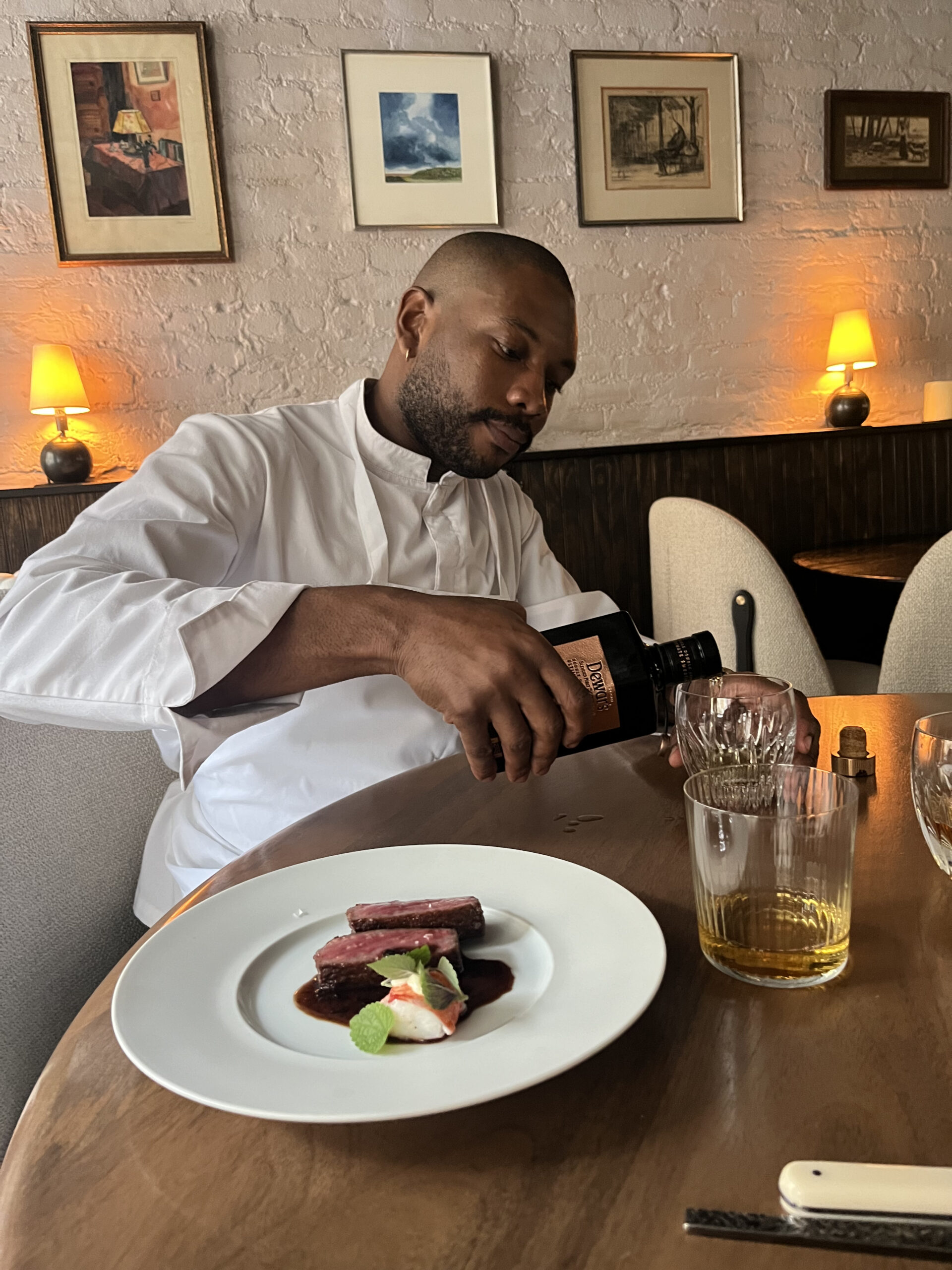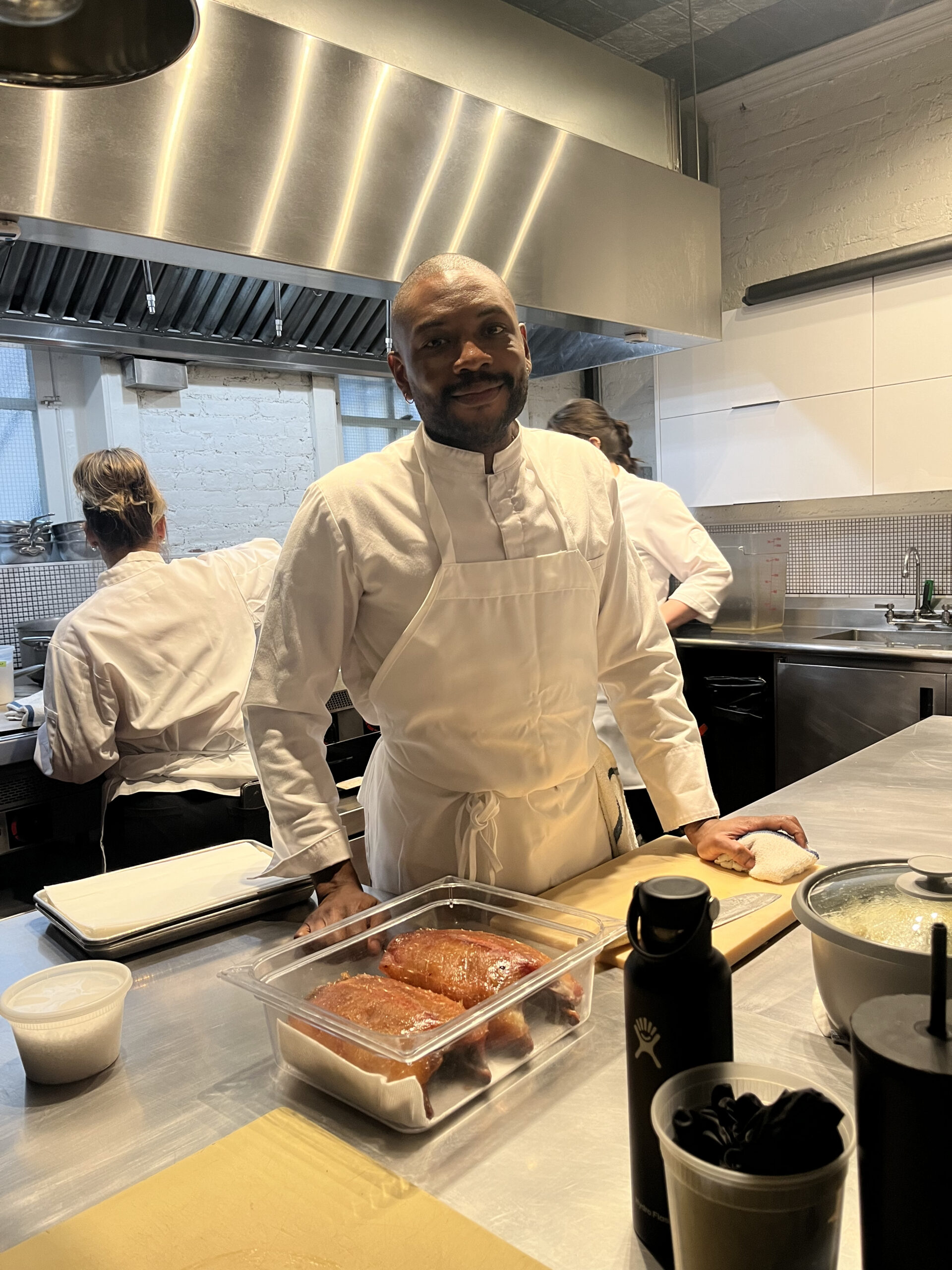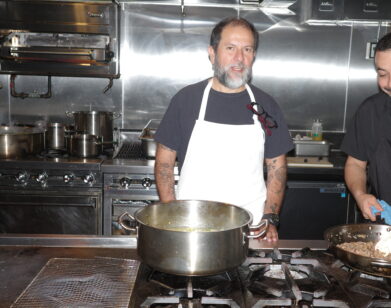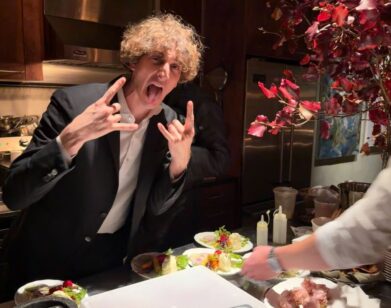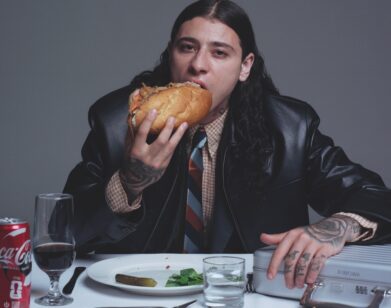YES, CHEF
Chef Charlie Mitchell Tells Us What It’s Like to Get a Michelin Star
In 2019, the Detroit-born chef Charlie Mitchell had a job lined up at a restaurant in Norway. Then Covid struck, plans were halted, and Michell, who cut his teeth in the kitchens of Villanelle and Eleven Madison Park, two cornerstones of New York fine dining, got a text from Clay Castillo, the owner of Clover Hill, who wanted to reopen his cozy, 34-seat outpost in Brooklyn Heights post-pandemic—with Mitchell as his Executive Chef. “I felt that I’d be doing myself a disservice not to at least try,” the 31-year-old told me on a brisk day in December as he walked me through the restaurant’s holiday menu, a collaboration with the acclaimed French chef Gabriel Kreuther. “It was about taking a new approach to fine dining, making it more us and a little bit more Brooklyn as well.”
Mitchell did more than merely try. Within a year, he became the first Black chef in New York City to be awarded a Michelin star (he was nominated for a James Beard, too) and had cemented Clover Hill as a beacon of Brooklyn fine dining, without all the fuss and pretension that designation ordinarily bestows. “We’re just cooking for people,” he explained. “It’s just a little smaller, cuter, with some caviar on top.” Last month, as Mitchell and Kreuther rolled out a prix fixe menu of dishes conceived to be enjoyed with a 37-year-old malt by Dewar’s, I stopped by the restaurant for a lesson in whiskey pairings.
———
JAKE NEVINS: I’m meeting you on an opportune day, because I just watched the new Frederick Wiseman documentary about a Michelin-starred restaurant in Central France. It seemed to contradict how kitchens are often shown in pop culture, which is loud and chaotic and borderline abusive. What’s the vibe here at Clover Hill?
CHARLIE MITCHELL: The vibe here is not like that. I try to create an environment where it’s safe to learn. And in those kitchens where you’re getting screamed at and chased around, you’re not really learning. We’re still not perfect. It is a very emotional process. We all care about food, and we care about cooking for people, and we care about cleaning and all the little things. But no one needs to be screamed at, you know what I mean? We’re just cooking for people. It’s just a little smaller, cuter, with some caviar on top.
NEVINS: Right. And a Michelin star.
MITCHELL: And a Michelin star, right?
NEVINS: How did that feel?
MITCHELL: Initially, we were in disbelief, we were very surprised. And then that turned into being lucky, being thankful, being grateful. I’ve been cooking for 11 years. To achieve something like that, it’s like, “Okay, cool. This is the beginning of my career as a chef.” I’ve been a cook for so long, and a sous chef, but this is my career as a chef, so it really was like, “Okay, man, this hard work has been paying off.” And then secondly, we’re a smallish restaurant, so for us it was a relief. It’s like, “Cool, we’re going to stay in business.” New York City is rough, man.
NEVINS: Especially post-Covid.
MITCHELL: A lot of restaurants still don’t make it.
NEVINS: What’s the Clover Hill origin story?
MITCHELL: It’s actually funny because this place opened in 2019, I was trying to move out of the country and go be a cook. I actually had a job lined up in Norway. A friend of mine was opening this restaurant, so I was working two jobs and saving to move out of the country. And then Covid happened, and New York is like ground zero, so the world shuts down. I leave and I go to Detroit, then I go to D.C. I moved back here in 2021. I took a job at a restaurant opening in Tribeca, but that didn’t go my way. And then I randomly got a text from Clay [Castillo], the owner here, and he was like, “Yo, Charlie, what are you up to?” And I was like, “Actually, nothing. I’m unemployed. What’s up?” We ended up getting coffee and he let me know he was trying to reopen the restaurant. We talked about his goals, my goals, and eventually just said, “Yeah, let’s do it.”
NEVINS: Wow. So you’d be in Norway right now if things went differently.
MITCHELL: I would’ve been, yeah. That was my goal, to get out of the country, and somehow I just ended that back here.
NEVINS: Just stuck in the mud here in New York. With a Michelin star.
MITCHELL: Yeah. I felt that I’d be doing myself a disservice not to at least try.
NEVINS: I’m curious, in a very competitive and oversaturated New York restaurant landscape, what you feel distinguishes Clover Hill?
MITCHELL: It was about taking a new approach to fine dining, making it more us and a little bit more Brooklyn as well. We wanted to really cover hospitality from all angles, and we felt like there was a void in fine dining. There was no place that had great service and great food and great music, that wasn’t pretentious, that was comfortable and hospitable. We just felt like that was missing and we still do. I think it’s special to eat the food we serve and be able to laugh and joke and feel comfortable and have a good time. A lot of the time, casual restaurants take all that business. We just felt like, “Why can’t you go out and have a fine dining meal and be comfortable and not feel so nervous?”
NEVINS: It’s very cozy here.
MITCHELL: Exactly. The direction is seafood-focused, vegetable-focused, and we really try to bring big flavors. It’s all about really good, honest cooking, treating good ingredients very honestly.
NEVINS: What are some of your signature dishes?
MITCHELL: We change the menu every season so it’s kind of hard to pick a favorite. But on the last couple menus, it’s been our rice dish. That one has carried over a little bit. And we do a grits dish, which is pretty special because it catches people off guard. It’s like grits and uni. With fine dining, you expect nice seafood and caviar and all that kind of stuff at our price point. But I think those dishes where the ingredients are cheaper, where we highlight big flavors, that sets us apart.
NEVINS: This is a really fancy water bottle.
MITCHELL: Yeah, it’s pretty fancy.
NEVINS: And over the holidays, you guys did a special whiskey pairing menu.
MITCHELL: This project was very interesting because, number one, Dewars was offering us high-end products, which we thought was kind of crazy from a restaurant standpoint. You normally don’t make cocktails with 32-year-old whiskey. People don’t even want to drink that stuff straight. They don’t really see it as something that can be manipulated or created into something more special. We thought that was very inspiring. And then to cook with it was also different. Every day here, we pair with wine. So it was an interesting challenge to take something like whiskey and try to catch all the nuances of it and then try to cook food that was tailored around it. I’m like, “Oh, shit, how am I supposed to cook with this whiskey?” So, for me it was all about imagination.
NEVINS: Trial and error.
MITCHELL: Right. And just imagining how this whiskey is going to make you feel, then figuring out what flavors and what feelings you want to create with the food to pair together. Some things were more obvious.
NEVINS: Like what?
MITCHELL: Like, whiskey and cooking with grains. It’s made from grain, barley, so you should cook with grains, right? It makes sense as a pairing. Or the sweet notes in it and the caramel, the wood it’s aged in. But for me, it was more like, how does it make me feel when I drink it? I’m a chef, not a beverage person. They get into all that, the wood, the oak, the notes, the smell.
NEVINS: Were there any surprises?
MITCHELL: There were a lot of surprises with the whiskeys themselves. I was impressed by the range of this blended scotch that they had. And I was excited about the option of turning them into cocktails. I think the cocktail pairings made the whiskeys a little bit softer as far as eating it with the food.
NEVINS: What do you drink after a long day at work?
MITCHELL: I’ve had phases. It used to be a cheap light beer, and then it went to whiskey. I think right now it’s either champagne or whiskey.
SERVER: This is our kosher curry rice course, with maitake mushrooms and Norwegian king crab.
MITCHELL: This is the one that was aged in Mizunara. We did it with Japanese rice, which is like fried rice that’s traditionally used in Japanese cooking. It’s a play on dirty rice, which is a southern dish that I ate growing up. So it’s a play on some really high-end Japanese shit, but with spice and mushrooms. And it’s got some pepper and butter and crab to pull it down. The whole point of this one was, again, preparing with whiskey and not wine. So, it was more about the fattiness and the mouth-feel, the decadence, the contrast with the way the whiskey kind of coats your mouth.
NEVINS: Yeah, I’m getting that.
MITCHELL: And then the fat from the beef, the whiskey, the feeling it created was the most important thing. The flavors shine, too, but it’s more about, “How does this feel in my mouth?”
NEVINS: Do I go in for a bite right after I’ve sipped the whiskey? What’s the best way to do this?
MITCHELL: I mean, this is straight whiskey, so it’s up to you. For me, I eat my food and I have a sip here and there and probably have some water, because it’s a little bit aggressive.
NEVINS: Right, it’s aged 21 years. [Eats]. Wow, okay. It does pair beautifully. I couldn’t necessarily tell you why, because I don’t have the vocabulary to explain it, but it just works.
MITCHELL: It works, right? That’s what I mean. Sometimes it’s like, “Why does this work?” But that’s the feeling I want. Then you have to make it sound scientific after the fact. It’s like caviar and champagne. It just works. It doesn’t really matter why.
NEVINS: Yeah. This other one is aged 37 years. Is that older than you?
MITCHELL: Yeah, I’m 31.
NEVINS: It’s older than me, too.
MITCHELL: So it was like, “What do we serve with this?” You want people to have something luxurious and decadent and special. You shouldn’t be eating this with a cheeseburger. It’s refined and sexy. That’s a poached blue lobster that we fly in from Europe and we just simply steam, warm it. And you have a very rich sauce with the truffle.
NEVINS: Do you eat it in one bit?
MITCHELL: If I was on a date, I would cut it in half. If I was by myself, I would eat the whole piece.
NEVINS: I see.
MITCHELL: Shellfish and beef is kind of a theme we have going here.
NEVINS: There’s king crab in here, right?
MITCHELL: Yeah.
NEVINS: Yeah. I’m from Maryland, so I’m picky about my crabs. When I was young, my dad told me never to order crab outside of Maryland. But this is an exception.
MITCHELL: This is nice. This is the Norwegian king crab. We don’t fuck around with some Peekytoe. Peekytoe crab is nice.
NEVINS: Right. Can you tell me about the sauce?
MITCHELL: It’s a truffle jus and truffle puree. We charge a supplement for $95. So, people come here, they pay a hundred bucks just for that plate of beef. It’s our job to make sure it’s cooked perfectly, make sure it’s sourced properly, and that it’s delivered in a timely manner. Otherwise, you don’t really hold up your end of the bargain, you know what I mean? The sourcing is a very big part of it.
NEVINS: Okay, there’s a real sensation going. It tastes very sophisticated.
MITCHELL: It just feels right.
NEVINS: I mean, I’m no food critic, but—
MITCHELL: I have no idea what I’m doing.
NEVINS: That can’t be true.
MITCHELL: Well, it’s very intuitive, to say the least.
NEVINS: Do you think so?
MITCHELL: Yeah. I mean, I have knowledge and experience, but it’s more about feel and intuition.
NEVINS: Right. Well, I have to finish the food before I head back to the office, now that I’ve had two like, 30-year-old whiskeys.
MITCHELL: Two whiskeys and you’re a little tipsy.

